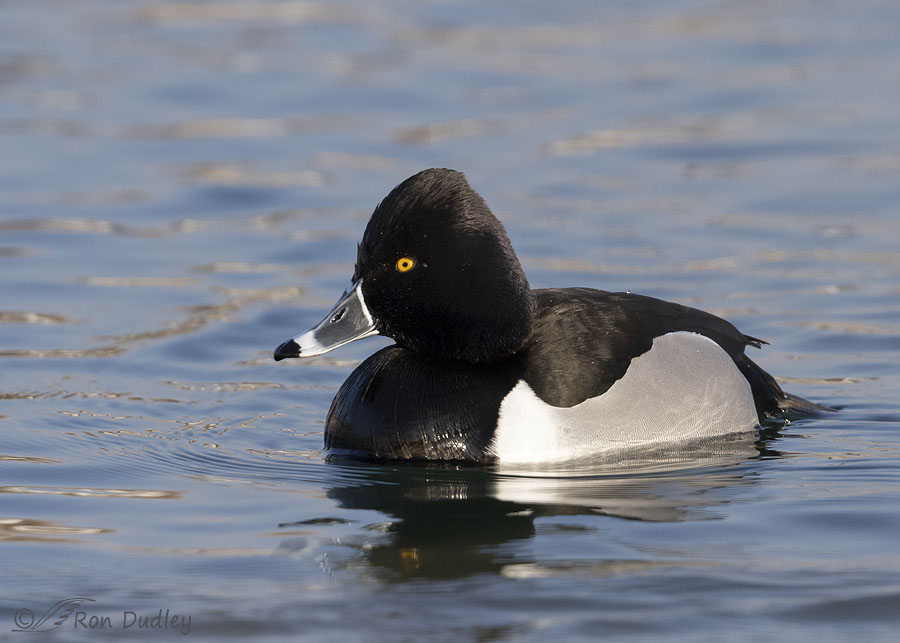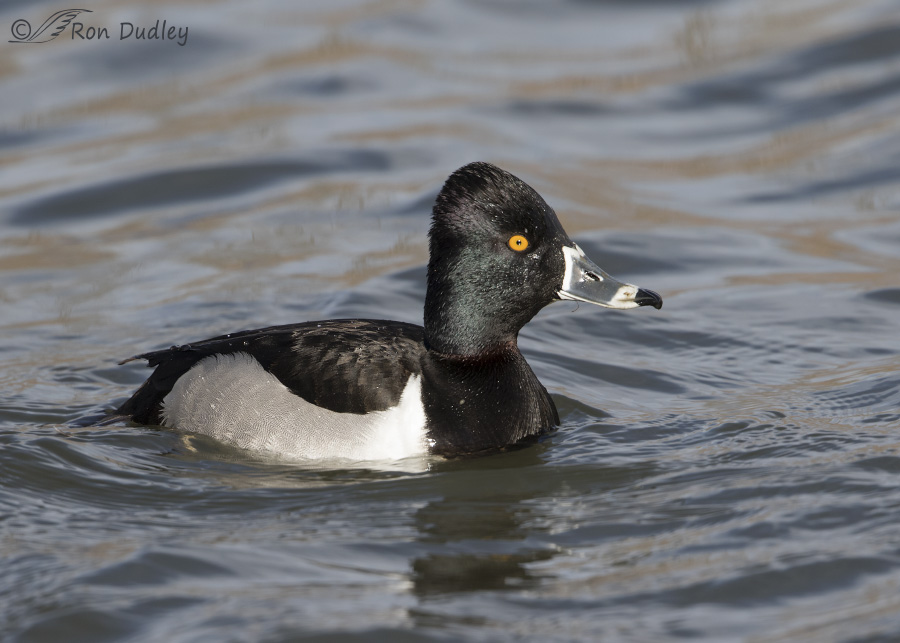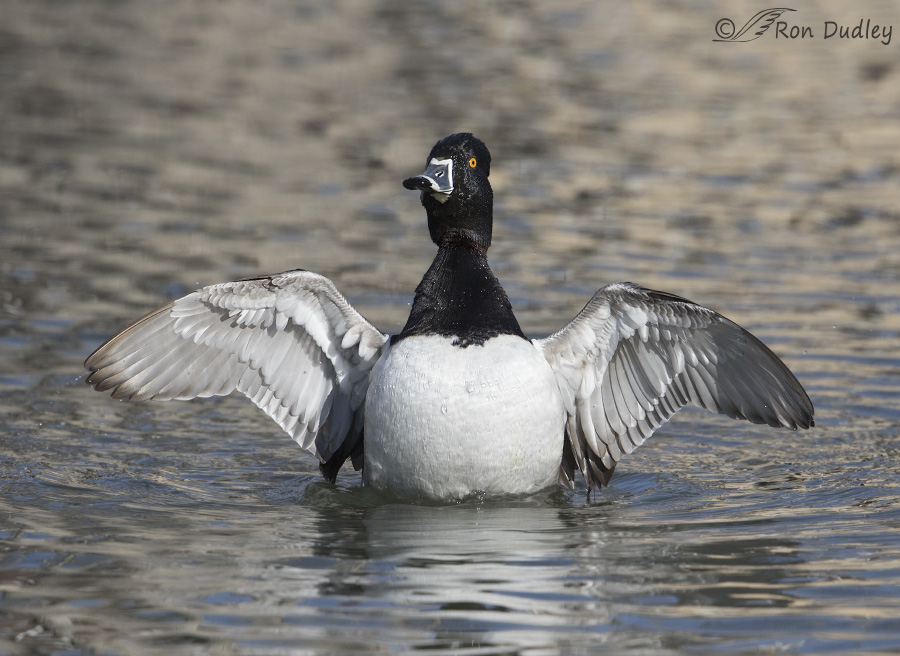A name change that’s long overdue.

1/3200, f/5.6, ISO 640, Canon R5, Canon EF500mm f/4L IS II USM + 1.4 tc, not baited, set up or called in
It’s been a while since I’ve photographed a drake Ring-necked Duck so late yesterday afternoon I was delighted to get this handsome dude filling my viewfinder. He’d been hiding amongst the reeds near the shore and very close to me for quite a while but I didn’t know he was there until a couple of hikers and their dog walked by and spooked him further out into the water where I could see him.
Every time I see a Ring-necked Duck, of either sex, I wonder… When are they going to change that atrociously inappropriate name?
They’re named for the narrow, dark-chestnut collar around the neck of the males but the collar (ring) is so ridiculously inconspicuous it can usually only be seen if the viewer is close, there’s bright light on the duck and the duck has stretched his neck by raising his head in an ‘alert’ position.
In this photo, and in most ‘looks’ viewers have of male ring-necks in the field, the namesake ring is impossible to see.

Even up close, in good light and with the neck stretched in a more alert pose, you have to look very carefully to see the ring. It actually can be seen in this older photo but it still isn’t very conspicuous.

This photo should give you an idea of how difficult the ring is to spot in the field. I was very close to this bird in bright light and his neck was extended but the ring is next to invisible. If you squint you can get some hints of it but not much more.
A much more appropriate common name for this species would be Ring-billed Duck. If you review these photos you’ll notice that this species has a conspicuous white band or ring bordered with a black tip on the end of its bill, a characteristic shared by all sexes and ages. Generations of hunters have referred to this species as “ring-bills” for good reason. Ring-necked Duck may seem like an appropriate name if the specimen is laying in front of you on a museum tray under bright lab lights but in the field it seems to me (and to many others) that the name serves no useful purpose and can even be misleading when the supposed neck ring can’t be observed.
So, as I suspect some of my readers already know, it’s possible (likely?) that the name of this duck is about to change. The American Ornithologists’ Union (AOU) now has a proposal before it to change the name from Ring-necked Duck to Ring-billed Duck. I support the proposal.
Its scientific name will still be Aythya collaris with the “collaris” species name referring to the neck ring so I hope that’s enough for the traditionalists.
Ron
Notes:
- I’ve incorporated some of the text from an older blog post I published about Ring-necked Ducks into today’s post, so I’d call this edition of Feathered Photography a “partial rerun”.
- I’m far from the only one clamoring for a name change for the Ring-necked Duck. If you’re interested, here’s a link to a well-reasoned (and I think somewhat amusing) article on the subject in Audubon, written by birder/English teacher Peter Cashwell. It’s been my experience that when an English teacher feels passionate about something, and writes about it, you’d better have your ducks in a row (sorry) before you take issue with what they’ve said. Peter fits precisely into that mold.


Very nice photos. Who knew people and a dog would be a photographic aid?
I agree with the name change, although an expert birder I was with today said “why?” when I mentioned the possible name change (after reading your post). Sometimes experts just don’t get it.
Lyle, I can see some reasons to resist making too many name changes, including the fact that new DNA research is making so many name changes necessary it all begins too much for some folks.
But this name is so inappropriate I think it should be at the top of the list of upcoming name changes.
Time to make Thag proud! After reading your 2nd paragraph, the term, “Ring-billed,” immediately popped into my head, so even non-birdy people notice that particular field mark.
Ring-billed is a fitting name, isn’t it Marty. It should have been the name from day one.
Thag Simmons would be proud! “Ring-billed” gets my vote for two reasons: it’s sensible and it’s non-discriminatory (females will get their due, as Mr. Cash well notes). That drake is a very handsome fella, BTW. 😎
I agree with both of your reasons, Chris.
Amen to this Ron. We have them here and they are one of my favorite and most attractive ducks. I have always wanted to call the Ring-billed so like so many others will be very happy if the powers to be make that change. Thanks for making a point of this and for the excellent photos.
“Thanks for making a point of this”
Everett, let’s just hope the ‘powers that be’ pay attention and act on it. It’s long, long overdue.
Looking at the 1st photo I thought “huh? what ring? ” 😉 Ringed Bill WOULD be appropriate. Not familiar with this fowl but he’s a beautiful bird. 🙂 Appears it might have a crest at times?
“Appears it might have a crest at times?”
Yes, Judy. It’s described as a “short crest”.
Excellent series!
Thanks, Charlotte.
Oh yes, this should pass. How can we get new birders invested when there are obstacles like this?
By the way, thank you for all the special posts lately. I can’t believe how much I can still learn from seeing the birds ‘up close’ and in behavioral poses as you photograph them, and with your text. Just a joy every morning, even familiar chickadees (for example) are new through your lenses.
Thank goodness that you are recovering.
“How can we get new birders invested when there are obstacles like this?”
Good point, Cheryl – one I should have mentioned in my post.
And thank you for the thoughtful and kind words.
I always have to translate the ring-bill in my head to ring-necked when reporting on ebird. I welcome the change. I also wonder, since so many different languages are involved in bird reporting around the world, if we should just go back to the scientific names because they are the same everywhere. That would be a ton of name learning for most everyone but why should the English name be the correct one in South America?
Your first sentence says it all, Pam.
Personally I think we need both common names and scientific names. I believe Latin names would be too cumbersome for so many folks that a whole slew of competing common names would work their way into usage, resulting in even more confusion.
Also, I believe that folks in countries that use languages other than English have common names in their languages for various species.
Oh well, I support it too. Its about time. I never had a clue WHY it was named ring-necked until right now this minute. I figured whoever named it was smoking something. Anyway, we have always called them ring bills. So lets make it legal.
“we have always called them ring bills. So lets make it legal.”
My sentiments exactly, Connie.
One. This a new bird to me so thank you for that.
Two. I wholeheartedly agree with you.
Three. He’s quite the looker!
Always happy to introduce my readers to a new bird, Arwen. Thanks.